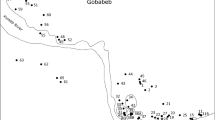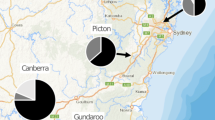Summary
Genetic relatedness and mating structure of the red ant, Myrmica ruginodis, were studied from a large data set in several natural populations, one of which was a substructured archipelago population. Within-colony relatedness of worker nestmates was measured as genotypic correlation and mating structure as deviation from random mating; both were calculated from the genotype frequency data. The average relatedness of worker nestmates was rather high across populations (0.43–0.73), and random mating was the rule within populations. The data were used to deduce the social structure of populations. With one possible exception, populations turned out to be weakly polygynous, implying that they consisted of the macrogyne form of the species. The exceptional population was relatively more polygynous and inbred, suggesting that it might include the microgyne form. This exceptional population lived in a habitat not noticeably different from that of the other populations, challenging previous suggestions of the habitat specialization of the two forms. The colonies were facultatively polygynous, and a comparison with earlier studies shows that polygyny is functional. Relatedness of worker nestmates varied slightly among populations, indicating that the social structure of Myrmica colonies is flexible.
Similar content being viewed by others
References
Ayala FJ, Valentine JW, Barr LG, Zumwalt GS (1974) Genetic variability in a temperate intertidal phoronid Phoronopsis viridis. Biochem Genet 11:413–427
Bennett B (1986) Nestmate recognition, intracolonial relatedness, and ecology of monogynous and polygynous ants. PhD thesis, University Microfilms International, Ann Arbor
Boomsma JJ, Grafen A (1990) Intraspecific variation in ant sex ratios and the Trivers-Hare hypothesis. Evolution 44:1026–1034
Boomsma JJ, Grafen A (1991) Colony-level sex ratio selection in the eusocial Hymenoptera. J Evol Biol 3:383–407
Bourke AFG, Have van der TM, Franks NR (1988) Sex ratio determination and worker reproduction in the slave-making ant Harpagoxenus sublaevis. Behav Ecol Sociobiol 23:233–245
Brian MV, Brian AD (1949) Observations on the taxonomy of the ants Myrmica rubra L. and M. laevinodis Nylander (Hymenoptera: Formicidae). Trans R Entomol Soc Lond 100: 393–409
Brian MV, Brian AD (1955) On the two forms macrogyna and microgyna of the ant Myrmica rubra L. Evolution 9:280–290
Craig R, Crozier RH (1979) Relatedness in the polygynous ant Myrmecia pilosula. Evolution 33:335–341
Crozier RH (1979) Genetics of sociality. In: Hermann H (ed) Social insects, vol I. Academic Press, New York, pp 223–286
Crozier RH, Pamilo P (1986) Relatedness within and between colonies of a queenless ant species of the genus Rhytidoponera (Hymenoptera: Formicidae). Entomol Gener 11:113–117
Crozier RH, Pamilo P, Crozier YC (1984) Relatedness and microgeographic geoetic variation in Rhytidoponera mayri, an Australian arid-zone ant. Behav Ecol Sociobiol 15:143–150
Elmes GW (1973) Observations on the density of queens in natural colonies of Myrmica rubra L. (Hymenoptera: Formicidae). J Anim Ecol 42:761–771
Elmes GW (1978) Populations of Myrmica (Formicidae) living on different types of Calluna moorland a semi-natural habitat of southern England. Memorabilia Zool 29:41–60
Elmes GW (1980) Queen numbers in colonies of the ants of the genus Myrmica. Ins Soc 27:43–60
Elmes GW (1987) Temporal variation in colony populations of the ant Myrmica sulcinodis I. Changes in queen number, worker number and spring production. J Anim Ecol 56:559–571
Elmes GW (1990) The regulation of polygyny and queen cycles in red ants (Myrmica). In: Veeresh GK, Mallik B, Viraktamath CA (eds) Social insects and environment. Proceedings of the 11th international congress of IUSSI 1990. Oxford IBH Publishing Co. PVT. LTD., New Delhi, pp 249–250
Elmes GW (1991) Mating strategy and isolation between the two forms, macrogyna and microgyna, of Myrmica ruginodis (Hym. Formicidae). Ecol Ent 16:411–423
Elmes GW, Clarke RT (1981) A biometric investigation of variation of workers of Myrmica ruginodis Nylander (Formicidae). In: Howse PE, Clement J-L (eds) Biosystematics of social insects. Academic Press, London, pp 121–140
Elmes GW, Petal J (1990) Queen number as an adaptable trait: evidence from wild populations of two red ant species (genus Myrmica). J Anim Ecol 59:675–690
Gadagkar R (1990) A test of the role of haplodiploidy in the evolution of Hymenopteran eusociality. In: Veeresh GK, Mallik B, Viraktamath CA (eds) Social insects and environment. Proceedings of the 11th international congress of IUSSI 1990. Oxford IBH Publishing Co. PVT. LTD., New Delhi, pp 539–540
Hamilton WD (1964) The genetic evolution of social behavior. J Theor Biol 7:1–52
Hamilton WD (1972) Altruism and related phenomena, maily in social insects. Ann Rev Syst Ecol 3:193–232
Harris H, Hopkinson DA (1976) Handbook of enzyme electrophoresis in human genetics. North Holland, Amsterdam
Have TM van der, Boomsma JJ, Menken SBJ (1988) Sex investment ratios and relatedness in the monogynous ant Lasius niger (L.). Evolution 142:160–172
Heinze J (1990) Dominance behavior among ant females. Naturwissenschaften 77:41–43
Heinze J, Smith TA (1990) Dominance and fertility in a functionally monogynous ant. Behav Ecol Sociobiol 27:1–10
Hölldobler B, Wilson EO (1977) The number of queens: an important trait in ant evolution. Naturwissenschaften 65:8–15
Hölldobler B, Wilson EO (1990) The ants. Springer, Berlin Heidelberg New York
Kasugai M, Takeda S, Sakurai H (1983) Some observations on the microgyne form of ant Myrmica ruginodis Nylander (Hymenoptera, Formicidae) in Sapporo. Kontyo 51:73–79
Li CC, Horvitz DG (1953) Some methods of estimating the inbreeding coefficient. Am J Hum Genet 5:107–117
Metcalf RA, Whitt GS (1977) Intra-nest relatedness in the social wasp Polistes metricus. A genetic analysis. Behav Ecol Sociobiol 2:339–351
Mizutani A (1981) On the two forms of the ant Myrmica ruginodis Nylander (Hymenoptera, Formicidae) from Sapporo and its vicinity, Japan. Jpn J Ecol 31:131–137
Oinonen EA (1956) On the ants of the rocks and their contribution to the afforestation of rocks in southern Finland (in Finnish with English summary). Acta Ent Fennica 12
Pamilo P (1981) Genetic organization of Formica sanguinea populations. Behav Ecol Sociobiol 9:45–50
Pamilo P (1982) Genetic population structure in polygynous Formica ants. Heredity 48:95–106
Pamilo P (1983) Genetic differentiation within subdivided populations of Formica ants. Evolution 37:1010–1022
Pamilo P (1984) Genotypic correlation and regression in social groups: multiple alleles, multiple loci and subdivided populations. Genetics 107:307–320
Pamilo P (1985) Effect of inbreeding on genetic relatedness. Hereditas 103:195–200
Pamilo P (1989) Estimating relatedness in social groups. Trends Ecol Evol 4:353–355
Pamilo P (1990 a) Sex allocation and queen-worker conflict in polygynous ants. Behav Ecol Sociobiol 27:31–36
Pamilo P (1990b) Comparison of relatedness estimators. Evolution 44:1378–1382
Pamilo P (1991 a) Evolution of colony characteristics in social insects 1. Sex allocation. Am Nat 137:83–107
Pamilo P (1991 b) Evolution of colony characteristics in social insects 2. Number of reproductive individuals. Am Nat 138:412–433
Pamilo P (1991c) Evolution of the sterile caste. J Theor Biol 149:75–95
Pamilo P (1991 d) Life span of queens in the ant Formica exsecta. Insect Soc 38:111–119
Pamilo P, Crozier RH (1982) Measuring genetic relatedness in natural populations: methodology. Theor Pop Biol 21:171–193
Pamilo P, Rosengren R (1984) Evolution of nesting strategies of ants: genetic evidence from different population types of Formica ants. Biol J Linn Sec 21:331–348
Pamilo P, Varvio-Aho S (1979) Genetic structure of nests in the ant Formica sanguinea. Behav Ecol Sociobiol 6:91–98
Pearson B (1982) Relatedness of normal queens (macrogynes) in nests of the polygynous ant Myrmica rubra (L.). Evolution 36:107–112
Pearson B (1983) Intra-colonial relatedness amongst workers in a population of nests of the polygynous ant, Myrmica rubra Latreille. Behav Ecol Sociobiol 12:1–4
Punttila P, Haila Y, Pajunen T, Tukia H (1991) Colonisation of clearcut forests by ants in the southern Finnish taiga: a quantitative survey. Oikos 61:250–262
Queller DC, Goodnight KF (1989) Estimating relatedness using genetic markers. Evolution 43:258–275
Ross KG (1986) Kin selection and the problem of sperm utilization in social insects. Nature 323:798–800
Ross KG (1988) Differential reproduction in multiple-queen colonies of the fire ant Solenopsis invicta (Hymenoptera: Formicidae). Behav Ecol Sociobiol 23:341–355
Ross KG, Fletcher DJC (1985) Comparative study of genetic and social structure in two forms of the fire ant Solenopsis invicta (Hymenoptera: Formicidae). Behav Ecol Sociobiol 17:349–356
Seifert B (1988) A taxonomic revision of the Myrmica species of Europe, Asia Minor and Caucasia (Hymenoptera, Formicidae). Abh Ber Naturkundemus Görlitz 62(3):1–75
Snyder LE, Herbers JM (1990) Seasonal polydomy and allocation ratios in the ant Myrmica punctiventris. Behav Ecol Sociobiol 28:409–415
Stille M, Stille B, Douwes P (1991) Polygyny, relatedness and nest founding in the polygynous myrmicine ant Leptothorax acervorum (Hymenoptera; Formicidae). Behav Ecol Sociobiol 28:91–96
Sundström L (1989) Genetic relatedness and population structure in Formica truncorum (Hymenoptera, Formicidae). Actes Coll Insectes Sociaux 5:93–100
Trivers RL, Hare H (1976) Haplodiploidy and the evolution of the social insects. Science 191:249–263
Varvio-Aho S, Pamilo P (1980) A new buffer system with wide applicability. Isozyme Bull 13:114
Wahlund S (1928) Zusammensetzung von Populationen und Korrelationserscheinungen vom Standpunkt der Vererbungslehre aus betrachtet. Hereditas 11:65–106
Ward PS (1983) Genetic relatedness and colony organization in a species complex of ponerine ants 1. Phenotypic and genotypic composition of colonies. Behav Ecol Sociobiol 12:285–299
Wright S (1951) The genetical structure of populations. Ann Eugenics 15:323–354
Yarrow IHH (1955) The type species of the ant genus Myrmica Latreille. Proc R Entomol Soc Lond (B) 24:113–115
Author information
Authors and Affiliations
Rights and permissions
About this article
Cite this article
Seppii, P. Genetic relatedness of worker nestmates in Myrmica ruginodis (Hymenoptera : Formicidae) populations. Behav Ecol Sociobiol 30, 253–260 (1992). https://doi.org/10.1007/BF00166710
Received:
Accepted:
Issue Date:
DOI: https://doi.org/10.1007/BF00166710




